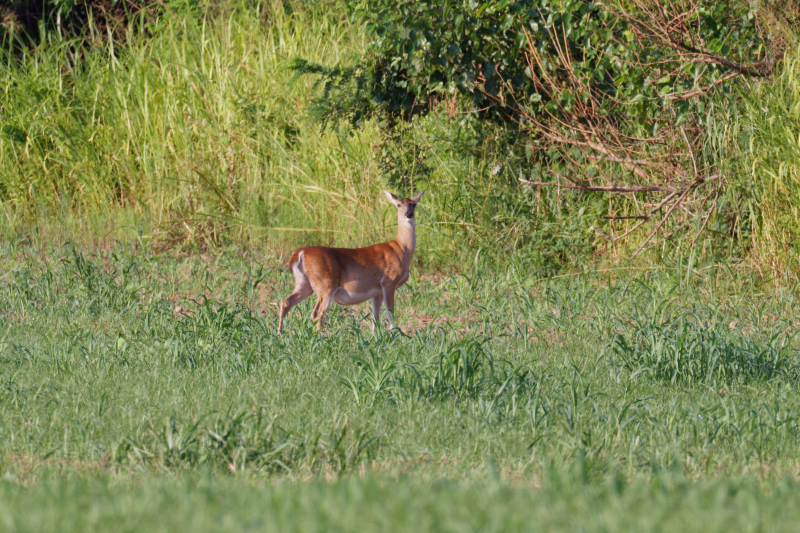On the morning of July 14, 2024, I experienced an unexpected and delightful moment while driving the auto tour road at Sequoyah National Wildlife Refuge. As I was making my way through the early morning light, I spotted a Whitetail Doe on the edge of a field. What caught my eye wasn’t just her presence but the noticeable size of her stomach. She appeared to be heavily pregnant, which is quite unusual for this time of year.

The Unusual Timing of the Doe’s Pregnancy
Typically, Whitetail Deer give birth in late spring or early summer, making a pregnant doe in mid-July a rare sight. My initial reaction was one of surprise and curiosity. Could she be carrying twins or even triplets? Such a large stomach suggested she might be expecting multiple fawns.
Understanding the Extended Breeding Season
Upon researching, I found that while unusual, this occurrence isn’t entirely inexplicable. Several factors can lead to a doe being pregnant later in the year:
Extended Breeding Season in the South
- Sporadic Rut Timing: Unlike the northern United States, where the breeding season (rut) is highly synchronized and typically occurs in November, the rut in southern states like Oklahoma can be much more spread out. The milder winters and less dramatic seasonal changes in the south provide a wider window of breeding opportunities. This means that some does can conceive later than their northern counterparts.
Possible Reasons for Late Pregnancy
- Second Estrus Cycle: If a doe does not conceive during her first estrus cycle, she will come into estrus again approximately 21 to 30 days later. This can result in later conception and, consequently, a later pregnancy.
- Environmental Factors: Local environmental conditions, such as food availability and habitat quality, can influence the timing of breeding and fawn births. The diverse and rich habitat of the Sequoyah National Wildlife Refuge may support a longer breeding season, allowing for pregnancies to extend into the summer months.
Gestation Period
The gestation period for Whitetail Deer is about 200 days, or roughly seven months. Therefore, a doe bred in late December or early January would be expected to give birth in late July or early August. This aligns with the possibility of a second estrus cycle or a generally extended breeding season in the region.
Conclusion
Seeing a pregnant Whitetail Doe in mid-July at the Sequoyah National Wildlife Refuge is a testament to the fascinating variability of nature. The extended and variable breeding season typical of southern states like Oklahoma allows for some does to conceive and carry their pregnancies later into the year. This remarkable sight reminds us of the endless surprises that nature holds, especially in such a vibrant and diverse habitat.
Note: In the blog post “Witnessing a Pregnant Whitetail Doe,” I share my experience of observing a pregnant Whitetail Doe at the Sequoyah National Wildlife Refuge in Oklahoma. In this post, I describe the doe’s visible pregnancy and discuss the birth process of Whitetail Does in detail, noting that they typically give birth to one to three fawns, with twins being common. I also explain that pregnant does exhibit behavioral changes as they prepare for birth.
